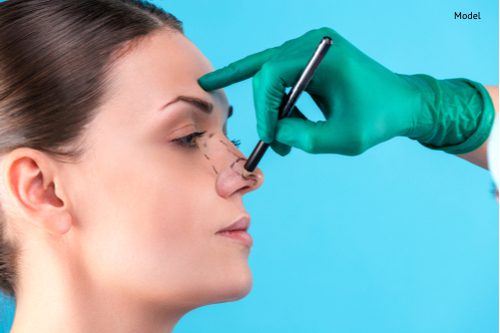How Is Rhinoplasty Performed?
Posted September 13, 2019 in Rhinoplasty
Nasal aesthetics play a significant role in the overall shape of your face, and when a patient feels insecure about their nose, it is a confidence-damaging factor that can be difficult to overcome.

Rhinoplasty offers the surgical correction of the nose to remove unwanted bumps and humps, or reshape upturned/downturned nasal tips and flared nostrils. Although it is commonly performed, a good rhinoplasty takes millimetric precision, and is one of the most challenging cosmetic surgeries to perform. Whether this is your initial rhinoplasty or revision rhinoplasty, it is crucial to choose a knowledgeable and skilled surgeon like Dr. Durand.
What Are Your Rhinoplasty Options?
Rhinoplasty is highly tailored to the patient and their specific needs. Since rhinoplasty can offer either augmentation or reduction of the nasal profile, there is no one-size-fits-all approach. There are two options for your rhinoplasty incision.
The Closed Technique
Closed rhinoplasty is a technique in which incisions are made on the inside of the nose only. With closed rhinoplasty, there are no external scars, and all modifications are made through the nostril incisions. This technique can be used to reduce nasal humps, alter the shape of the bridge, or adjust the tip.
The Open Technique
The closed and open techniques do not differ that much. The only difference is that open rhinoplasty includes an additional incision across the columella (the strip of skin and tissue that separates the nostrils). The open technique allows for a more direct visual and is often chosen for more significant alterations. While this technique does involve an external incision, it heals very well and is not usually visible to the naked eye. The appropriate rhinoplasty technique will depend on your specific nasal concern, and your options will be discussed with you during your consultation.

Septoplasty
Septoplasty is a variation of rhinoplasty that focuses on the repair of the inner structure and the return of nasal functionality, instead of the aesthetic appearance. A deviated septum occurs when the cartilage that separates the nasal passages is off-center or uneven, causing one passage to be smaller than the other. This condition can be genetic or the result of trauma. Regardless, it will significantly affect your ability to breathe and can lead to other side effects, such as headaches or trouble sleeping. A septoplasty traditionally utilizes the closed approach. The septal tissue is lifted, and the bone and cartilage of the septum are repositioned and reshaped. This allows for more even airflow. Septoplasty is not aesthetic nasal surgery, but it is often combined with rhinoplasty to improve aesthetics as well as function.
How Are Common Aesthetic Nasal Concerns Fixed?
 Rhinoplasty is one of the few surgeries that can either augment or reduce the size of the nose. Everyone wants their nose to be in balance and harmony with the rest of their facial features. Some may be born with smaller noses that lack projection or noses that present a flatter bridge. Augmentation is performed by adding autologous cartilage grafts (usually taken from the nasal septum) to the nasal bridge or tip. This cartilage will add volume and shape to the bridge or tip so that it matches your surrounding facial features. Autologous tissue is the preferred augmenting material (because there is less chance of reaction or rejection), but synthetic grafts (or implants) are also available.
Rhinoplasty is one of the few surgeries that can either augment or reduce the size of the nose. Everyone wants their nose to be in balance and harmony with the rest of their facial features. Some may be born with smaller noses that lack projection or noses that present a flatter bridge. Augmentation is performed by adding autologous cartilage grafts (usually taken from the nasal septum) to the nasal bridge or tip. This cartilage will add volume and shape to the bridge or tip so that it matches your surrounding facial features. Autologous tissue is the preferred augmenting material (because there is less chance of reaction or rejection), but synthetic grafts (or implants) are also available.
Reduction of the nasal profile is achieved by gently shaving down any excess bone or cartilage. Flared nostrils are reduced by removing a small wedge of skin and tissue from the corners of the nostril (where the nostril meets the cheek).
How Does Your Anatomy Alter Technique?
The thickness of a patient’s skin and cartilage will differ depending on their ethnicity and genetics. Because of this, a technique that works for one patient may not work for another. This is another reason that it is crucial to choose a surgeon that understands the unique variations in nasal anatomy.
Contact Us Today
For more information on rhinoplasty, contact Careaga Plastic Surgery today by calling (305) 960-7511 or by filling out our online contact form.
